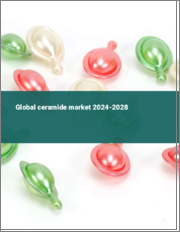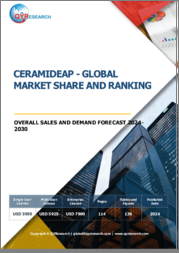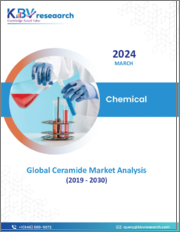
|
시장보고서
상품코드
1525309
세계의 피토스핑고신 시장 규모 조사 : 용도별, 지역별 예측(2022-2032년)Global Phytosphingosine Market Size Study, by Application (Cleansing Wipes, Moisturizers, Facewash, Others) and Regional Forecasts 2022-2032 |
||||||
세계 피토스핑고신 시장은 2023년 약 12억 7,000만 달러로 평가되었고, 예측 기간인 2024년부터 2032년까지 6.01%의 견실한 성장률로 성장할 것으로 예상됩니다.
피토스핑고신은 효모 발효에서 추출한 지질로 컨디셔닝 및 항균 작용을 합니다. 지질 합성을 조절하고 천연 보습을 보장하며 항균 및 항염증 효과를 제공하여 건강한 피부를 유지하는 데 중요한 역할을 합니다. 피토스핑고신은 여드름 증상을 완화하고 피부 미생물의 활동을 제한하며 발적과 염증을 억제하는 능력이 있어 세안제, 헤어 컨디셔너, 클렌징 물티슈, 페이셜 스크럽 등 다양한 화장품에 널리 사용되고 있습니다. 또한, 제약 산업에서 피토스핑고신의 사용이 증가함에 따라 2024-2032년의 예측 기간 동안 세계 피토스핑고신 시장에 수익성 있는 기회를 제공할 것으로 예상됩니다.
시장 성장의 원동력은 젊은 층의 여드름 방지 제품에 대한 수요 증가와 바이오 화장품에 대한 선호도 증가입니다. 가처분 소득 증가와 화장품 산업의 확대는 시장을 더욱 활성화시킬 것입니다. 또한, 개발도상국의 도시화와 젊은 층의 인식 증가도 피토스핑고신 수요의 한 요인으로 작용하고 있습니다. 생물학적 활성 제품의 도입은 예측 기간 동안 시장 성장을 위한 몇 가지 기회를 창출할 것으로 예상됩니다. 그러나 피토스핑고신의 높은 비용, 낮은 생산성 및 안정적이지 않은 수율은 큰 도전 과제입니다. 또한, 특히 미개척 및 신흥 지역의 소비자 인식 부족은 시장 성장에 걸림돌이 될 것으로 예상됩니다.
세계 피토스핑고신 시장의 주요 지역으로는 북미, 유럽, 아시아태평양, 라틴아메리카, 중동 및 아프리카가 있으며, 2023년 아시아태평양은 2024-2032년 동안 가장 빠른 CAGR을 보이며 세계 피토스핑고신 시장을 주도할 것으로 예상되며, 2024-2032년 동안 가장 빠른 CAGR을 보일 것으로 예상됩니다. 이는 이 지역의 견고한 화장품 및 퍼스널케어 산업이 주도하고 있습니다. 중산층 인구가 증가하고 가처분 소득이 증가함에 따라 중국, 일본, 한국 등의 소비자들은 고품질 스킨케어 제품을 점점 더 많이 찾고 있습니다. 항염증 및 항균 작용으로 알려진 피토스핑고신은 많은 스킨케어 제품의 주요 성분입니다. 또한, 이 지역의 제약 및 생명공학 분야의 확장은 시장을 더욱 촉진하고 있습니다. 아시아태평양은 연구개발에 대한 활발한 투자와 피부 건강과 미용에 대한 인식이 높아짐에 따라 피토스핑고신 시장에서 압도적인 강세를 보이고 있습니다. 규제 당국의 지원과 활발한 제조거점도 이 지역 시장 리더십에 기여하고 있습니다.
목차
제1장 세계의 피토스핑고신 시장 : 주요 요약
- 세계의 피토스핑고신 시장 규모와 예측(2022-2032년)
- 지역별 개요
- 부문별 개요
- 용도별
- 주요 동향
- 불황의 영향
- 애널리스트의 결론 및 제안
제2장 세계의 피토스핑고신 시장 정의와 조사의 전제조건
- 조사 목적
- 시장의 정의
- 조사의 전제조건
- 포함과 제외
- 제한 사항
- 공급측 분석
- 가용성
- 인프라
- 규제 환경
- 시장 경쟁
- 경제성(소비자 시점)
- 수요측 분석
- 규제 프레임워크
- 기술 진보
- 친환경
- 소비자 의식과 수용
- 조사 방법
- 조사 대상년도
- 통화 환산율
제3장 세계의 피토스핑고신 시장 역학
- 시장 성장 촉진요인
- 시장이 해결해야 할 과제
- 시장 기회
제4장 세계의 피토스핑고신 시장 : 산업 분석
- Porter's Five Forces 모델
- 공급 기업의 교섭력
- 바이어의 교섭력
- 신규 진출업체의 위협
- 대체품의 위협
- 경쟁 기업간 경쟁 관계
- Porter's Five Forces 모델에 대한 미래적 접근
- Porter's Five Forces의 영향 분석
- PESTEL 분석
- 정치
- 경제
- 사회
- 기술
- 환경
- 법률
- 주요 투자 기회
- 주요 성공 전략
- 파괴적 동향
- 업계 전문가의 견해
- 애널리스트의 결론 및 제안
제5장 세계의 피토스핑고신 시장 규모와 예측 : 용도별, 2022-2032년
- 부문 대시보드
- 세계의 피토스핑고신 시장 : 용도별 매출 동향 분석, 2022년·2032년
- 클렌징 물티슈
- 보습제
- 세안료
- 기타
제6장 세계의 피토스핑고신 시장 규모와 예측 : 지역별, 2022-2032년
- 북미
- 미국
- 캐나다
- 유럽
- 영국
- 독일
- 프랑스
- 스페인
- 이탈리아
- 기타 유럽
- 아시아태평양
- 중국
- 인도
- 일본
- 호주
- 한국
- 기타 아시아태평양
- 라틴아메리카
- 브라질
- 멕시코
- 기타 라틴아메리카
- 중동 및 아프리카
- 사우디아라비아
- 남아프리카공화국
- 기타 중동 및 아프리카
제7장 경쟁 정보
- 주요 기업의 SWOT 분석
- 주요 시장 전략
- 기업 개요
- Beckmann-Kenko GmbH
- 주요 정보
- 개요
- 재무(데이터 입수가 가능한 경우)
- 제품 개요
- 시장 전략
- Avanti Polar Lipids Inc
- AK Scientific Inc
- Tokyo Chemical Industry Co Ltd
- Sungwun Pharmacopia Co Ltd
- Sigma-Aldrich Co. LLC
- MolPort
- Evonik Industries AG
- Doosan Corporation
- BOC Sciences
- Beckmann-Kenko GmbH
제8장 조사 과정
LSH 24.08.22The Global Phytosphingosine Market was valued at approximately USD 1.27 billion in 2023 and is expected to grow with a healthy growth rate of 6.01% over the forecast period 2024-2032. Phytosphingosine is a lipid derived from yeast fermentation with conditioning and antibacterial properties. It plays a crucial role in maintaining healthy skin by regulating lipid synthesis, ensuring natural moisturization, and providing antibacterial and anti-inflammatory benefits. Phytosphingosine is widely used in various cosmetic products, such as face washes, hair conditioning agents, cleansing wipes, and facial scrubs, owing to its ability to reduce acne symptoms, limit microorganism activity on the skin, and reduce redness and inflammation. Furthermore, the increased use of phytosphingosine in the pharmaceutical industry presents profitable opportunities for the Global Phytosphingosine Market during the forecast period 2024-2032.
The market growth is driven by the increasing demand for anti-acne products among the younger population and a growing preference for bio-based cosmetic products. The rising disposable income and the expansion of the cosmetics industry further fuel the market. Additionally, urbanization and increased awareness among the youth in developing countries contribute to the demand for phytosphingosine. The introduction of bioactive products is expected to create several opportunities for market growth during the forecast period. However, the high costs of phytosphingosine, low productivity, and inconsistent yields are significant challenges. Additionally, the lack of consumer awareness, particularly in undeveloped and emerging regions, is anticipated to hamper market growth.
The key region in the Global Phytosphingosine Market includes North America, Europe, Asia Pacific, and Latin America, & Middle East & Africa. In 2023, Asia-Pacific is anticipated to lead the global phytosphingosine market and expected to witness the fastest CAGR during the forecast period 2024-2032. This is driven by the region's robust cosmetics and personal care industry. With a growing middle-class population and rising disposable incomes, consumers in countries like China, Japan, and South Korea are increasingly demanding high-quality skincare products. Phytosphingosine, known for its anti-inflammatory and antimicrobial properties, is a key ingredient in many skincare formulations. Additionally, the region's expanding pharmaceutical and biotechnology sectors further boost the market. Strong investments in research and development, coupled with a growing awareness of skin health and beauty, position Asia-Pacific as a dominant force in the phytosphingosine market. Regulatory support and a thriving manufacturing base also contribute to the region's market leadership.
Major market players included in this report are:
- Evonik Industries AG
- Doosan Corporation
- BOC Sciences
- Beckmann-Kenko GmbH
- Avanti Polar Lipids, Inc.
- AK Scientific Inc.
- Tokyo Chemical Industry Co., Ltd.
- Sungwun Pharmacopia Co. Ltd.
- Sigma-Aldrich Co. LLC
- MolPort
The detailed segments and sub-segment of the market are explained below:
By Application
- Cleansing Wipes
- Moisturizers
- Facewash
- Others
By Region:
- North America
- U.S.
- Canada
- Europe
- UK
- Germany
- France
- Spain
- Italy
- ROE
- Asia Pacific
- China
- India
- Japan
- Australia
- South Korea
- RoAPAC
- Latin America
- Brazil
- Mexico
- Rest of Latin America
- Middle East & Africa
- Saudi Arabia
- South Africa
- RoMEA
Key Takeaways:
- Market Estimates & Forecast for 10 years from 2022 to 2032.
- Annualized revenues and regional level analysis for each market segment.
- Detailed analysis of geographical landscape with Country level analysis of major regions.
- Competitive landscape with information on major players in the market.
- Analysis of key business strategies and recommendations on future market approach.
- Analysis of competitive structure of the market.
- Demand side and supply side analysis of the market.
Table of Contents
Chapter 1. Global Phytosphingosine Market Executive Summary
- 1.1. Global Phytosphingosine Market Size & Forecast (2022-2032)
- 1.2. Regional Summary
- 1.3. Segmental Summary
- 1.3.1. By Application
- 1.4. Key Trends
- 1.5. Recession Impact
- 1.6. Analyst Recommendation & Conclusion
Chapter 2. Global Phytosphingosine Market Definition and Research Assumptions
- 2.1. Research Objective
- 2.2. Market Definition
- 2.3. Research Assumptions
- 2.3.1. Inclusion & Exclusion
- 2.3.2. Limitations
- 2.3.3. Supply Side Analysis
- 2.3.3.1. Availability
- 2.3.3.2. Infrastructure
- 2.3.3.3. Regulatory Environment
- 2.3.3.4. Market Competition
- 2.3.3.5. Economic Viability (Consumer's Perspective)
- 2.3.4. Demand Side Analysis
- 2.3.4.1. Regulatory frameworks
- 2.3.4.2. Technological Advancements
- 2.3.4.3. Environmental Considerations
- 2.3.4.4. Consumer Awareness & Acceptance
- 2.4. Estimation Methodology
- 2.5. Years Considered for the Study
- 2.6. Currency Conversion Rates
Chapter 3. Global Phytosphingosine Market Dynamics
- 3.1. Market Drivers
- 3.1.1. Rising Demand for Anti-Acne Products
- 3.1.2. Growing Preference for Bio-Based Cosmetic Products
- 3.1.3. Increased Disposable Income and Cosmetics Industry Expansion
- 3.2. Market Challenges
- 3.2.1. High Costs of Phytosphingosine
- 3.2.2. Low Productivity and Inconsistent Yields
- 3.2.3. Lack of Consumer Awareness in Emerging Regions
- 3.3. Market Opportunities
- 3.3.1. Introduction of Bioactive Products
- 3.3.2. Expansion in Pharmaceutical Industry
- 3.3.3. Increased Use in Skincare Products
Chapter 4. Global Phytosphingosine Market Industry Analysis
- 4.1. Porter's 5 Force Model
- 4.1.1. Bargaining Power of Suppliers
- 4.1.2. Bargaining Power of Buyers
- 4.1.3. Threat of New Entrants
- 4.1.4. Threat of Substitutes
- 4.1.5. Competitive Rivalry
- 4.1.6. Futuristic Approach to Porter's 5 Force Model
- 4.1.7. Porter's 5 Force Impact Analysis
- 4.2. PESTEL Analysis
- 4.2.1. Political
- 4.2.2. Economical
- 4.2.3. Social
- 4.2.4. Technological
- 4.2.5. Environmental
- 4.2.6. Legal
- 4.3. Top Investment Opportunity
- 4.4. Top Winning Strategies
- 4.5. Disruptive Trends
- 4.6. Industry Expert Perspective
- 4.7. Analyst Recommendation & Conclusion
Chapter 5. Global Phytosphingosine Market Size & Forecasts by Application 2022-2032
- 5.1. Segment Dashboard
- 5.2. Global Phytosphingosine Market: Application Revenue Trend Analysis, 2022 & 2032 (USD Billion)
- 5.2.1. Cleansing Wipes
- 5.2.2. Moisturizers
- 5.2.3. Facewash
- 5.2.4. Others
Chapter 6. Global Phytosphingosine Market Size & Forecasts by Region 2022-2032
- 6.1. North America Phytosphingosine Market
- 6.1.1. U.S. Phytosphingosine Market
- 6.1.1.1. Application breakdown size & forecasts, 2022-2032
- 6.1.2. Canada Phytosphingosine Market
- 6.1.1. U.S. Phytosphingosine Market
- 6.2. Europe Phytosphingosine Market
- 6.2.1. U.K. Phytosphingosine Market
- 6.2.2. Germany Phytosphingosine Market
- 6.2.3. France Phytosphingosine Market
- 6.2.4. Spain Phytosphingosine Market
- 6.2.5. Italy Phytosphingosine Market
- 6.2.6. Rest of Europe Phytosphingosine Market
- 6.3. Asia-Pacific Phytosphingosine Market
- 6.3.1. China Phytosphingosine Market
- 6.3.2. India Phytosphingosine Market
- 6.3.3. Japan Phytosphingosine Market
- 6.3.4. Australia Phytosphingosine Market
- 6.3.5. South Korea Phytosphingosine Market
- 6.3.6. Rest of Asia Pacific Phytosphingosine Market
- 6.4. Latin America Phytosphingosine Market
- 6.4.1. Brazil Phytosphingosine Market
- 6.4.2. Mexico Phytosphingosine Market
- 6.4.3. Rest of Latin America Phytosphingosine Market
- 6.5. Middle East & Africa Phytosphingosine Market
- 6.5.1. Saudi Arabia Phytosphingosine Market
- 6.5.2. South Africa Phytosphingosine Market
- 6.5.3. Rest of Middle East & Africa Phytosphingosine Market
Chapter 7. Competitive Intelligence
- 7.1. Key Company SWOT Analysis
- 7.2. Top Market Strategies
- 7.3. Company Profiles
- 7.3.1. Beckmann-Kenko GmbH
- 7.3.1.1. Key Information
- 7.3.1.2. Overview
- 7.3.1.3. Financial (Subject to Data Availability)
- 7.3.1.4. Product Summary
- 7.3.1.5. Market Strategies
- 7.3.2. Avanti Polar Lipids Inc
- 7.3.3. AK Scientific Inc
- 7.3.4. Tokyo Chemical Industry Co Ltd
- 7.3.5. Sungwun Pharmacopia Co Ltd
- 7.3.6. Sigma-Aldrich Co. LLC
- 7.3.7. MolPort
- 7.3.8. Evonik Industries AG
- 7.3.9. Doosan Corporation
- 7.3.10. BOC Sciences
- 7.3.1. Beckmann-Kenko GmbH
Chapter 8. Research Process
- 8.1. Research Process
- 8.1.1. Data Mining
- 8.1.2. Analysis
- 8.1.3. Market Estimation
- 8.1.4. Validation
- 8.1.5. Publishing
- 8.2. Research Attributes

















